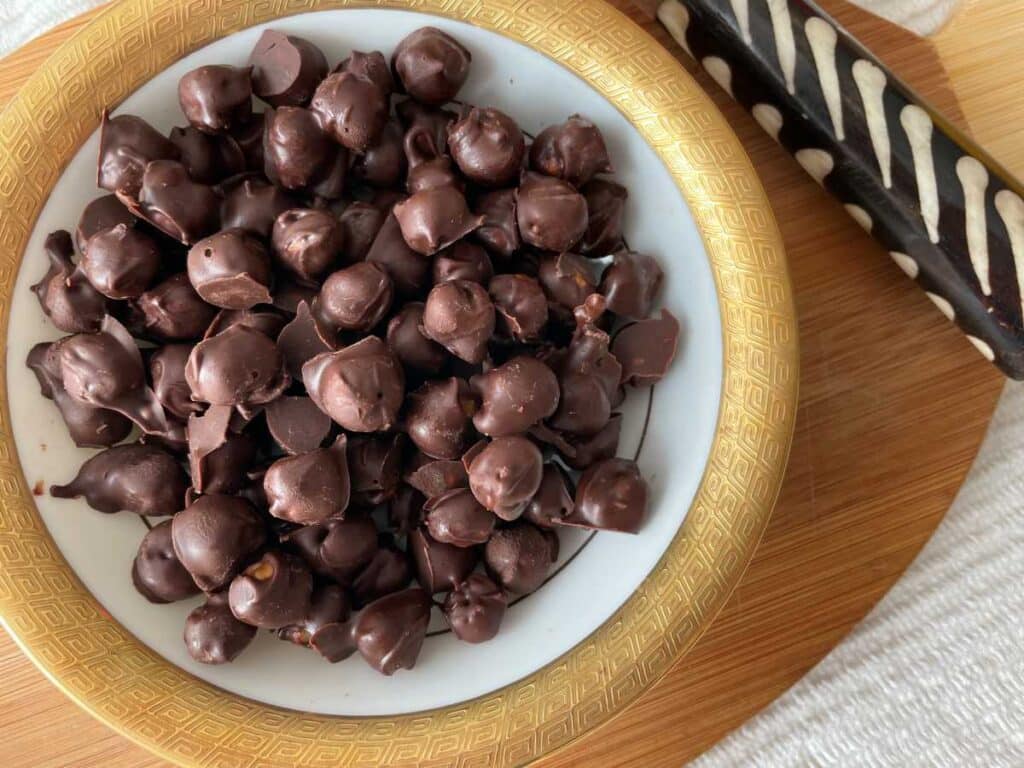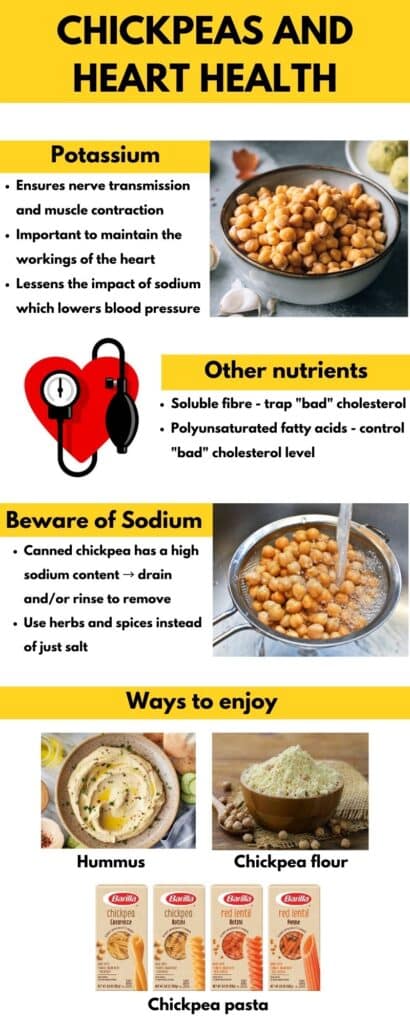Are you interested in learning if chickpeas as a good source of potassium? Well, you are in the right place!
In this article, we will discuss the amount of potassium in chickpeas, why potassium is important in heart health and how to include more chickpeas in your eating pattern.
This article was written by Shirley Le, Nutrition Student, and Veronica Rouse, MAN, RD, CDE.
Top Takeaways
- Potassium is an essential mineral crucial for normal bodily functions, including maintaining heart rhythm and regulating blood pressure. Adequate potassium intake is important for heart health.
- Chickpeas are a good source of potassium, with about 291 mg of potassium per 100 g of dried chickpeas when cooked. However, canned chickpeas contain significantly less potassium (about 126 mg per 100 g) due to the canning process.
- Consuming chickpeas can benefit heart health not only because of their potassium content but also due to their soluble fiber, which can help lower LDL cholesterol levels. To include more chickpeas in your diet, consider using them in various dishes like hummus, falafel, or soups, but be mindful of added sodium in canned chickpeas and opt for “no salt added” varieties or rinse them thoroughly.
Potassium And Heart Health
What Is Potassium And What Does It Do In Our Body
Potassium is one of many essential minerals that our body depends upon for normal functioning. It becomes an electrolyte, a positive ion that can conduct electricity, making it responsible for muscle (and heart) contractions as well as nerve transmissions.
Potassium helps cells stay electrically connected to each other to maintain the heart’s rhythm or heartbeat (1). It also outweighs the impact of sodium by increasing sodium excretion via urine (1). All these functions can protect the heart from stroke and coronary heart diseases.
How Much Potassium Do North Americans Need?
Today, most people do not consume enough potassium as the average North American diet contains processed boxed food high in sodium and low in potassium which is a contributing factor to high blood pressure.
Thus, it remains a priority to ensure adequate intake of potassium in your diet. Adequate Intake (AI) is a recommended daily intake of specific nutrients. This table summarizes the AI for potassium in different age groups and life stages (2).
| Age/Life Stage Group | AI, g/d |
| 0-6 months | 0.4 |
| 7-12 months | 0.7 |
| 1-3 years | 3.0 |
| 4-8 years | 3.6 |
| 9-13 years | 4.5 |
| 14-18 years | 4.7 |
| 19-50 years | 4.7 |
| 50+ years | 4.7 |
| Pregnancy | 4.7 |
| Lactation | 5.1 |
Potassium And Heart Health Research
A heart-healthy diet incorporates potassium-rich food. In fact, eating enough potassium can effectively lower blood pressure (3). This way of eating is encouraged in the DASH diet; DASH is an acronym for Dietary Approaches to Stop Hypertension. A diet developed to focus on managing blood pressure.
The DASH diet focuses on increasing intakes of fruits and vegetables, whole grains, nuts and seeds, lean animal protein, and low-fat dairy products. Eating these foods provides a plethora of nutrients such as calcium, magnesium, potassium, plant-based protein, and fiber that support heart health (4).
During the DASH diet research trials, they measured the sodium and potassium in the urine of almost 3,000 participants and concluded that a higher sodium-to-potassium ratio is associated with a higher risk of cardiovascular diseases (5).
This means that eating more potassium-rich food and limiting the intake of salt effectively lowers blood pressure within just a few weeks of implementing the DASH diet (6).
What Is A Chickpea?
Chickpeas, also known as garbanzo beans, are a staple in many households for their nutritional value and versatility.
Chickpeas, scientifically referred to as Cicer arietinum, are one of the most ubiquitous legumes. The legumes are a staple and have been cultivated for thousands of years in the Middle East, India, and Africa.
People are familiar with yellow-dried and canned chickpeas but do not know that fresh chickpeas are green in color. The beans mature in fuzzy green pods which grow on vines.
There are two main types of chickpeas, desi, and Kabuli which are widely and commercially available. Desi is smaller with a rougher coat and a darker bean while Kabuli is larger with a smoother coat and brighter beans.
How Much Potassium In Chickpeas
Type: Dried Chickpeas
According to FoodData Central, 100 g of dried chickpeas, when cooked, will provide 291 mg of potassium (7).
Type: Canned Chickpeas
100 g of canned chickpeas provide 126 mg of potassium. That is about 50% LESS than dried chickpeas (8). This is because the liquid during canning removes potassium and other nutrients from chickpeas.
Do Cooking Methods Change Potassium Content
All forms of cooking will remove some potassium. This is because the chickpea absorbs water during the cooking process which dilutes the mineral content of the legume.
Pressure cooking and boiling chickpeas preserve potassium the best. They both only remove around 37% of potassium (10).
Another Reason Chickpeas Are Good For Heart Health
Raffinose is a soluble fiber in chickpeas that can form a gel-like consistency in your digestive tract which can trap and prevent “bad” low-density lipoprotein (LDL) cholesterol from entering your bloodstream.
Another way chickpeas protect your heart health is by providing polyunsaturated fatty acids (“good” fats) which also manage LDL cholesterol levels. Eating dietary pulses (like chickpeas, lentils, and beans) can significantly lower LDL cholesterol after 6 weeks (11).
Lowering the “bad” cholesterol prevents cholesterol from building up in your arteries, reducing the risk of cardiovascular diseases.

How To Eat Chickpeas For Heart Health
How Much Is A Serving?
One serving of chickpea is ¼ cup dry which doubles to ½ cup when cooked or ½ cup from a can.
How To Eat Them
Looking into cuisines from around the world, you can draw inspiration for ways to consume chickpeas.
Hummus, from the Middle East, is a delicious spread with chickpeas as its main ingredient. This is a great snack when paired with crunchy vegetables such as carrots, celery, chips, and crackers, creating a perfect on-the-go mini meal for those with a busy schedule.

My favorite way of including chickpeas is making this super easy 3 ingredient chocolate covered chickpeas.
Another way to include chickpeas is in falafel form, which is a great alternative to deli meats in sandwiches.
I also throw chickpeas into my soup to add protein with this tomato oatmeal soup.
Whatever way you choose to consume chickpeas, it is important to use other herbs and spices instead of salt to bring out flavors and entertain your taste buds.
Be Careful Of Added Sodium
Canned chickpeas also have a higher sodium content than dried chickpeas (246 mg in canned chickpeas vs 7 mg in fresh chickpeas) (7, 8). The sodium enhances the flavor of the legumes but excess intake means putting your heart at risk of cardiovascular diseases.
That being said, this problem has an easy solution. Drain the canning liquid and rinse the legumes to remove up to 47% sodium (12). The other option is to choose “no salt added” chickpeas. You can find this nutrition claim on the front of the package.

Final Thoughts On Potassium In Chickpeas
Potassium and other nutrients in chickpeas can control your blood pressure and protect your heart from cardiovascular risk. However, it is important to be conscious of sodium intake, especially from canned chickpeas.
If you are interested in other ways of adding potassium to your dietary pattern, subscribe to my newsletter for a FREE 7-day heart-healthy meal plan to get you started today!

